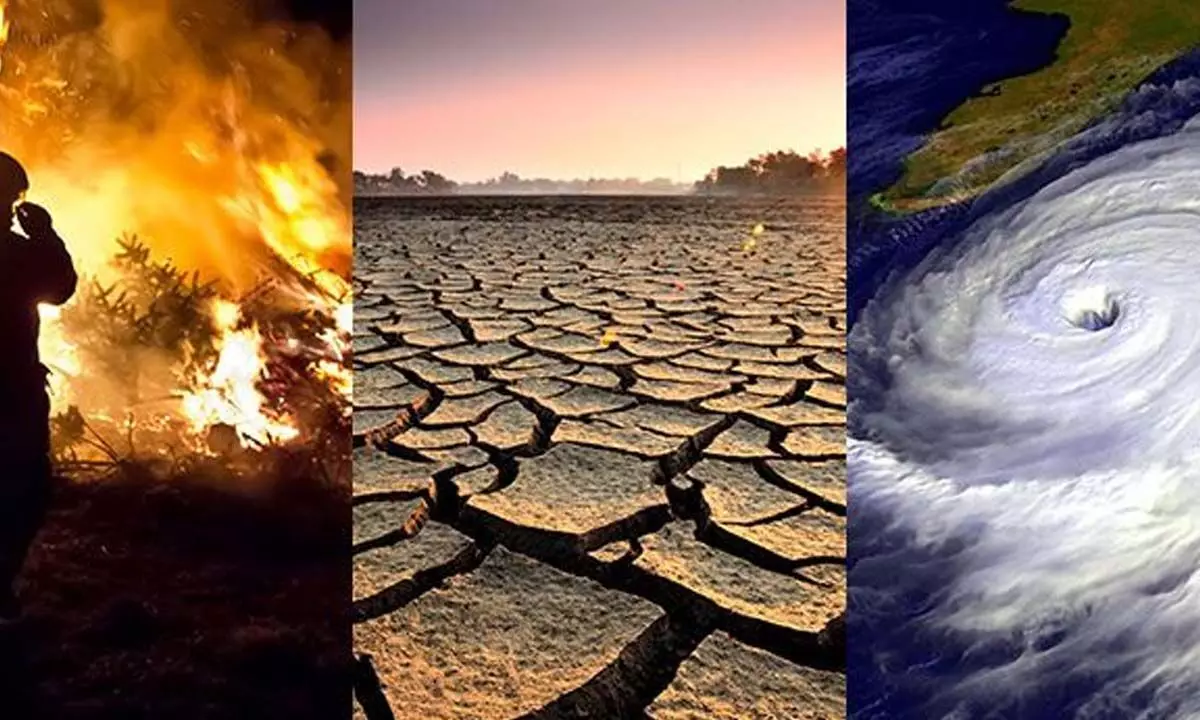Climate changes a cause for alarm

The exceptional warmth in June and at start of July occurred at the on-set of El Nino, expected to fuel the heat on land and in the oceans, leading to extreme temperatures and marine heatwaves. It is expected that as the
El Nino develops further, we may experience these impacts during 2024
According to an ongoing temperature analysis led by scientists at NASA’s Goddard Institute of Space Studies, the average global temperature on Earth has increased by 1.1 degrees Celsius since 1880. Due to rise in temperature, the things that we depend and value – water, energy, transportation, agriculture, ecosystems and human health – are experiencing the effects of climate change.
According to an ongoing temperature analysis led by scientists at NASA’s Goddard Institute of Space Studies, the average global temperature on Earth has increased by 1.1 degrees Celsius since 1880. Due to rise in temperature, the things that we depend and value – water, energy, transportation, agriculture, ecosystems and human health – are experiencing the effects of climate change.
The State of the Global Climate 2022 shows the planetary-scale changes on land, in the ocean and in the atmosphere caused by record levels of heat-trapping greenhouse gases (GHGs). The years 2015-2022 were the eight warmest on record, despite impact of a La Niña - cooling of ocean surface temperatures in central and east-central Pacific; event for past three years.
Extreme weather
events registered
In 2022, the world witnessed extensive and intense heatwaves, drought and floods, extreme weather events each month due to global warming and resultant climate change. The countries who contribute least GHGs like Pakistan, Madagascar and Ethiopia have had substantial impact due to these events, in spite of the year has La Nina. Extremely heavy rains battered Madagascar, from February to April, there were three tropical storms Emnati, Gombe and Jasmine causing more than 210 deaths and affecting about a million people. In South America, Argentina suffered from intense heatwaves and drought which triggered wildfires and decreased agriculture production.
Indian scenario
There were several heatwaves in 17 Indian states from March to June 2022, including Rajasthan and Madhya Pradesh and unusually heatwaves were also experienced in Himachal Pradesh for a month and Jammu and Kashmir. These extreme heatwaves are attributed to anticyclones – which cause hot and dry weather by sinking winds around high pressure systems in atmosphere.
The year 2022 didn’t witness any strong cyclones, despite ongoing La Nina conditions – which aid formation of intense cyclones. However, there were three cyclones in Bay of Bengal and Arabian sea of low intensity. Asani formed as a low pressure area in May, Mandous made landfall near Mahabalipuram in December and Sitrang along the Bangladesh coast in October.
In the third week of June 2022 came the deluge in the north-eastern states with extreme rainfall in a short span, while the western coast remained dry. July 2022 turned out to be driest July month on record for East and Northeast India. In August and September, there were floods in Bengaluru and in third week of September Delhi also suffered from floods due to incessant rains.
Triple-dip La Nina
According to World Meteorological Organization (WMO), part of the world experienced severe weather events in 2022 and they are being witnessed this year as well. It further mentions that it is due to rare “Triple-Dip La Nina” – multilayer cooling off the surface temperature of equatorial Pacific Ocean, which can cause droughts, high speed winds and heavy rainfall. The WMO mentions that La Nina began in September 2020, and if it continues till September 2023, it will be the first ‘triple-dip’ La Nina event of 21st century. From Indian point of view La Nina is reported not to be bad. In the US, it is associated with very dry winter, in Australia and Indonesia it may bring more rainfall. In Pakistan, excessive rainfall and flooding disaster during 2022 is attributed to La Nina.
Global events during 2023
Increasing temperatures and dry conditions have caused bigger and more dangerous wildfires. During February 2023, due to La Nina, wildfire in south central Chile led to 24 deaths, 2000 injuries and burning over 8 lakh acres of land. In Spain during March 2023, the blaze in 10,500 acres of land led to evacuation of 1,800 people. Similarly, Maui wildfire in Hawaii caused 55 deaths torching 1000 buildings.
Globally, July experienced unprecedented rise in temperature. July 2023 was Earth’s hottest month on record. The month was 1.5 degrees Celsius warmer than pre-industrial times and warmest on Earth in ten thousand years. June 2023 also recorded unparalleled sea surface temperatures and record-low Antarctic sea ice extent. The oceans are becoming warmer and absorbing energy that will remain there for hundreds of years.
The exceptional warmth in June and at start of July occurred at the on-set of El Nino, expected to fuel the heat on land and in the oceans, leading to extreme temperatures and marine heatwaves. It is expected that as the El Nino develops further, we may experience these impacts during 2024.
In June 2023, cyclone Biparjoy, the first cyclone which made its landfall in India hit Gujarat, bringing heavy rains in Maharashtra, MP and Rajasthan. It was a very severe cyclonic storm impacting more than 80,000 peoples, Gujarat was most affected by this cyclone.
The first fortnight of July 2023 witnessed unusual events for the planet’s climate, as records were broken with alarming regularity across continents, impacting more than two-thirds of the world population.
In some cases, new records got broken within hours. Beijing, China, July last week received heaviest rains in 140 years including surrounding province of Hebei hit by severe flooding. In India, it was seen first in northern region around July 6. A western disturbance - low pressure originates in Mediterranean region and moved towards India and interacts with low-pressure southwest monsoon. This interaction results in extreme rainfall and cloud burst, causing flash floods and massive landslides.
The consequences of this interaction were devastating encompassing Himachal Pradesh and states of Rajasthan and Punjab. The result was due to torrential rains, HP experiencing worst ever floods with over 100 deaths and huge economic loss. In some districts century old records were broken of rainfall, like Una district, 96 year old record was broken for rain in a single day on July 10. In the same way, as per director meteorology center Shimla. Lahaul-Spiti district has broken the record of 74 years.
It will be cataclysmic if humans do not slow climate change, global temperature may increase by 4 degrees Celsius by the year 2100. Therefore, there is need for finance to flow from developed countries to developing countries, to help them build resilience. There is also need across the world to reduce GHG emissions and get to zero as soon as possible. Since both forests and oceans play vital roles in regulating our climate, increasing natural ability of forests and oceans to absorb carbon dioxide is very important. The countries should move their economies away from fossil fuels and switch over to clean and renewable energy sources, in addition to sustainable transport - electric vehicles, to avoid existential threat arising from climate change. There is one issue that will determine the contours of the century more dramatically than any other, and that is urgent threat of a changing climate.
(Writer is a
retired IFS officer)




















